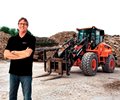Limestone exteriors bring out the best in notable buildings
Winter 2016
What do the Toronto Opera House, San Francisco’s St. Regis Hotel, the Butterfly Conservatory at Niagara Falls and Tiffany’s in New York City have in common? They are all showcase buildings in high-visibility locations. And they prominently feature limestone rock as a part of their exterior. More surprisingly, all the limestone came from the same place.
Those quarries, located on the Bruce Peninsula in southwestern Ontario, produce some of the world’s most spectacular limestone.
“Since many architects like the unique look of limestone, it is a popular choice for building exteriors,” says Tom Stobbe, owner (with his sister Linda) of Ledgerock Ltd. “Limestone always has the look of a quality product. That is why we have quite an impressive list of customers throughout North America and even around the world.”
What they don’t have is the luxury of time. Speedy delivery of a quality product is now the industry standard. For Ledgerock, the process begins at one of its three quarries (Owen Sound, Wiarton and Hope Bay), proceeds to the firm’s 100,000-square-foot fabrication shop and then onto building jobsites.
Mining the quarry takes strong, yet precise equipment
Ledgerock is the leading producer of Eramosa marble/limestone, Algonquin limestone, Hope Bay limestone and Mara limestone. A quarry consists of multiple layers of stone; some are thin (4 to 6 inches thick), others much thicker (up to 3 feet). Each layer has a unique texture and color.
The process of removing the stone includes cutting it into cubes with diamond-belt saws. The product is removed from the wall of the quarry using a Doosan DL250TC-3 wheel loader with a pallet fork attachment, which then carries the cubes to the fabrication plant (located at the Owen Sound quarry) or loaded onto trucks at the other two quarries for delivery to fabrication.
Removing and carrying the cubes has become more efficient since Ledgerock purchased the DL250TC-3, a tool carrier (TC), parallel-lift-arm machine designed for lift-and-carry applications. The wheel loader weighs 31,769 pounds and has a dump height of 9 feet.
The wheel loader, according to Stobbe, has several features that have improved the entire process. “The parallel lift arms provide the operator with excellent visibility,” he says. “You can actually see what the tips of the pallet forks are doing. Picture a wall 4 to 5 feet thick with multiple layers that might be a foot apart. To remove the cubes, you need to exert a little force to break them apart, so proper positioning of the forks is critical. If you cannot see the tips of the forks, it makes it very difficult.”
Stobbe points out that the machine keeps the pallet forks and the material level. “That means one less function the operator has to perform,” he notes. “It is very helpful.”
Another key feature: The wheel loader’s limited-slip differential helps ensure steady operation on uneven terrain. “The ground from the quarry to the fabrication building is rough, with a lot of sharp stones,” Stobbe says. “The DC250TC-3 does a nice job of keeping the load level.”
The hydraulic quick coupler, which allows the operator to change attachments quickly and easily, is also valuable.
“We change between pallet forks and buckets frequently,” Stobbe says. “After the blocks are removed with the forks, there is some cleanup required because they all do not come out as a solid piece. A cube that is cut to size may fall apart if it is fractured. So, being able to efficiently switch to the bucket for picking up the broken pieces is important.”
The wheel loader’s impressive performance in what Stobbe calls a demanding application is increasing its popularity around the facility.
“We are running 30 pieces of heavy equipment,” he says. “Some employees like one brand, some like another brand. And now we have a growing number of operators who prefer Doosan.”
Fabricating the stone
After the limestone cubes are delivered to the Ledgerock fabrication shop, the company’s high-tech equipment takes over, turning out a large variety of stone shapes and sizes.
For some orders the company supplies shop drawings (layouts of the stone) and shop tickets (used for cutting the stone). “For example,” says Stobbe, “if a customer wanted all flat panels on the outside of a building, we would provide drawings on how big the stones would have to be, what sides get polished and where the anchors would be drilled to hold the stone.”
For this premier supplier of limestone products, having a group of 150 talented employees, an almost unlimited supply of stone in the ground and some durable heavy equipment has enabled the company to keep up with the time-sensitive dealer and custom orders. Not to mention, leave their mark on buildings around the world.
“Long lead times are a thing of the past,” Stobbe says. “We are doing our best to keep up with the demand.”
 English
English



